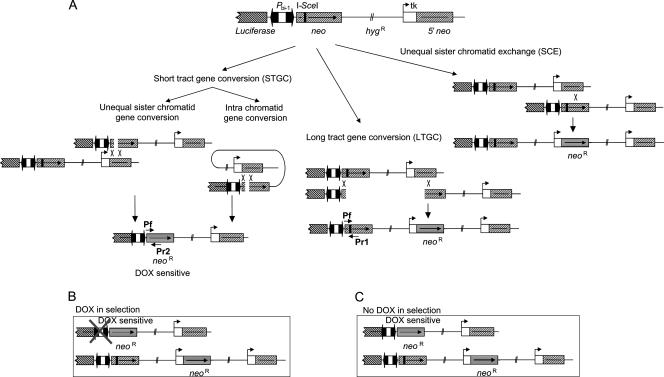FIG. 1.
Schematic illustration of the TARneo substrate. (A) The substrate contains two inactive neo repeats. The downstream neo gene is controlled by a constitutive thymidine kinase promoter and has a 3′ deletion, resulting in a nonfunctional gene product. The upstream neo gene includes the full coding sequence but has an I-SceI restriction site introduced that creates a stop codon. The two neo genes are in direct orientation, separated by a functional hygromycin resistance cassette. The full recombination substrate was subcloned into a commercial vector containing a bidirectional promoter (Pbi-1) based on a tetracycline-controlled system (TetOff) and allowed inducible transcription over the upstream neomycin gene. The TetOff promoter codirectionally controls the transcription of the construct and the reporter luciferase gene, enabling the quantification of transcription through the substrate (4). The Pbi-1 promoter is negatively controlled by the presence of the tetracycline derivative doxycycline (DOX). Transcription is turned off in the presence of doxycycline and turned on in its absence. The construct can revert back to its active form by recombination, and the recombinants can be selected using G-418. STGC gives rise to a recombination product in which the upstream neo gene controlled by the inducible promoter is reverted. The second recombination product is a result of either LTGC or SCE, in which the downstream neo gene is reverted. The primers used to distinguish between the products of STGC (Pf and Pr2) and LTGC/SCE (Pf and Pr1) are also depicted. (B) Presence of doxycycline during selection with G-418 turns off Pbi-1, leading to the selection of LTGC/SCE alone since the product of STGC is not expressed. (C) When there is no doxycycline during selection, both the products of STGC and LTGC/SCE are selected with G-418.

